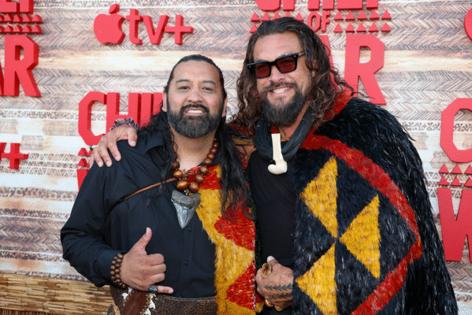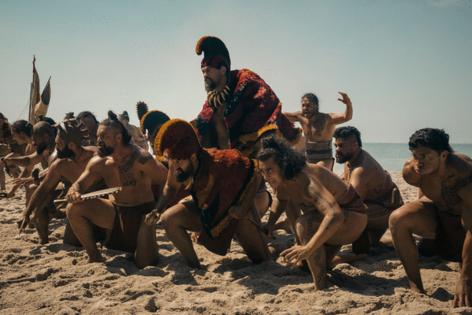Q&A: 'Chief of War' co-creator on Jason Momoa, Hawaiian stories
Published in Entertainment News
SEATTLE — Before “Chief of War,” the history of Hawaiʻi had never been front and center in a mainstream Hollywood production and told from a Native Hawaiian viewpoint. The Apple TV+ series, which premiered Aug. 1, follows Kaʻiana (Jason Momoa), a real-life warrior chief who tried to unify the islands in the late 1700s, before Western colonization. Created by Momoa and Thomas Paʻa Sibbett, a writer and producer who lives in Washington state, the show features a predominantly Polynesian cast and took years to make.
Growing up in Olympia, Sibbett, who is Hawaiian, said he was surrounded by large Hawaiian and Polynesian communities, often spending Saturdays doing crafts, dances and music with families in his neighborhood. As “Chief of War” continues to air, with its final episode dropping Sept. 19, Sibbett, who called in from his current home in McCleary, Grays Harbor County, gave us some behind-the-scenes insights and discussed using TV as a vehicle for storytelling.
This interview has been edited for length and clarity.
Q: What was the energy like when you and Momoa were writing the show together?
A: We’re both Hawaiian, but our personality is fairly different. I come from more of an academic background. I went to school for Hawaiian studies. … Jason’s got all this passionate energy, and he thinks very much like a director. For him, it’s about the feeling, the shots and what you want to see. So when I build a story, Jason really populates it with all of these great moments and locations. … We work really well together because we both bring something completely different to it.
Q: Why was it crucial that the show uses the Hawaiian language?
A: If we remove the language, then we remove the reality of what this story is actually based on. … Everything in this show can be pointed to something real. For example, people wonder, “Is that shark sequence real, in the first (episode)?” … Hawaiians had three different methods of catching shark, but we also have these really elaborate stories of swimming with sharks, why you swim with sharks and training exercises. Every Indigenous culture is very connected to the animals within their world. Hawaiians are no different; sea creatures are very much a part of their world, so I just took the concepts and stories of things that we know (from) our family, and we put it all together into a sequence.
Q: How was it decided to film the series in both Hawaiʻi and New Zealand?
A: We have a lineage connection. We speak a very similar language. … We could use production to reconnect these lineage lines, spend time with one another and support each other in storytelling.
I was talking to some of the extras when we were in New Zealand, and they were wearing Hawaiian regalia. I remember asking one of the Māori men — an Indigenous man of Aotearoa (the Māori name for New Zealand) — “How does it feel to wear that, because you’re Māori, but this is a Hawaiian costume?” … He walked to the beach and said, “I could feel the ancestors were present.” … We don’t have to tell (the extras) how to act because they know already. … The weapons made sense, and the story we’re trying to tell is very much a story they have.
Q: I’m sure it was special to see Polynesian cultures intertwining with one another, and getting to meet people from a different region as well.
A: It was a reflection of my upbringing. … Hawaiʻi is so diverse in its ethnic landscape that it was very natural. … Even as a child, I couldn’t surround myself with only Hawaiians. We were surrounded by Samoans, Tongans and people throughout the Pacific. … Not all of our extras are Hawaiian in Hawaiʻi. They were also Polynesian. When we went to Aotearoa (or) New Zealand, it was the same thing.
Q: A lot of Hawaiian stories have historically been passed down through oral storytelling. What was it like being able to map out something more visual for a wider audience?
A: It’s the highlight of my career. … This is a history that’s lived with me my entire life. I’ve been telling stories, performing stories, singing stories since I was 2 years old. That’s kind of a mandate in my family. We were raised to be people who share culture.
We’re not usually in control of our own narratives. … We hadn’t filled the space in the industry to be able to say that we were capable of doing it, because there is a level of professionalism that you have to carry in order to pull it off. … There aren’t a bunch of Polynesian writers, producers, directors and actors … but I do believe that with shows like this, I think the next great evolution for our people is film. It’s that next great avenue for us to be able to express ourselves. … When we can start telling stories that are completely universal but wrapped in our languages, culture, clothing and food, you just give people something uniquely different.
Q: What do you hope people will take away from watching “Chief of War”?
A: I really hope it starts a conversation on the expectation when you go to Hawaiʻi for tourism. … Understand that Hawaiians have their own story, have their own place and want to be heard. Don’t fly to Hawaiʻi with the expectation that you can receive paradise for the price of a plane ticket. When we have a mutual understanding — you know more about us and we know more about you — there can be this mutual give and take, as opposed to just complete consumption.
———
(Out of respect for the previously banned Hawaiian language, we are using diacritical marks in this Q&A that more accurately convey meaning and pronunciation.)
———
©2025 The Seattle Times. Visit seattletimes.com. Distributed by Tribune Content Agency, LLC.
















Comments